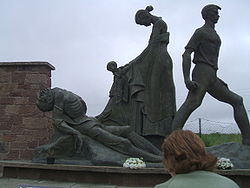
Ballyseedy
Encyclopedia

Townland
A townland or bally is a small geographical division of land used in Ireland. The townland system is of Gaelic origin—most townlands are believed to pre-date the Norman invasion and most have names derived from the Irish language...
in County Kerry
County Kerry
Kerry means the "people of Ciar" which was the name of the pre-Gaelic tribe who lived in part of the present county. The legendary founder of the tribe was Ciar, son of Fergus mac Róich. In Old Irish "Ciar" meant black or dark brown, and the word continues in use in modern Irish as an adjective...
, Ireland
Ireland
Ireland is an island to the northwest of continental Europe. It is the third-largest island in Europe and the twentieth-largest island on Earth...
. It was historically situated in the parish of Ballyseedy, within the barony
Barony (Ireland)
In Ireland, a barony is a historical subdivision of a county. They were created, like the counties, in the centuries after the Norman invasion, and were analogous to the hundreds into which the counties of England were divided. In early use they were also called cantreds...
of Trughanacmy
Trughanacmy
Trughanacmy is a barony in County Kerry, Ireland. The barony is an obsolescent administrative area, having ceased to have any government function since the enactment of the Local Government Act 1898.In 1881 the barony had an area of .-Name:...
. The townland contains a number of notable landmarks, including Ballyseedy Wood, a bridge over the Ballycarty River and a ruined Protestant
Protestantism
Protestantism is one of the three major groupings within Christianity. It is a movement that began in Germany in the early 16th century as a reaction against medieval Roman Catholic doctrines and practices, especially in regards to salvation, justification, and ecclesiology.The doctrines of the...
church. There is also a large restored castle (Ballyseedy Castle) which is in use as a hotel.
Location
Ballyseedy is located off the N21 road, 4 kilometres (2.5 mi) southeast of Tralee. A section of the River Lee, from which Tralee takes its name, forms the northern edge of the townland.History
Ballyseedy Wood is an ancient woodland dating at least to the 16th century16th century
As a means of recording the passage of time, the 16th century lasted from 1501 to 1600. It is regarded by historians as the century in which the rise of the West occurred....
, when it was mapped by Sir Edward Denny. The wood contains the ruins of Ballyseedy House (or Old Ballyseedy Castle). Alongside nearby "New" Ballyseedy Castle (now restored as a hotel), this was the seat of the Blennerhassett family from around 1586 to 1967.
Ballyseedy Massacre
The townland was the scene of an atrocity in the Irish Civil WarIrish Civil War
The Irish Civil War was a conflict that accompanied the establishment of the Irish Free State as an entity independent from the United Kingdom within the British Empire....
, in which eight anti-Treaty IRA prisoners were killed by their captors, members of the Free State
Irish Free State
The Irish Free State was the state established as a Dominion on 6 December 1922 under the Anglo-Irish Treaty, signed by the British government and Irish representatives exactly twelve months beforehand...
forces.
Demographics
- In the 2002 Census of Kerry, Ballyseedy had a population of 127.
- In the 2006 Census, it had a population of 474.
See also
- List of towns and villages in Ireland
- List of baronies of Ireland

